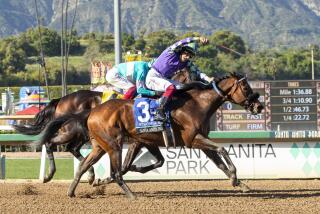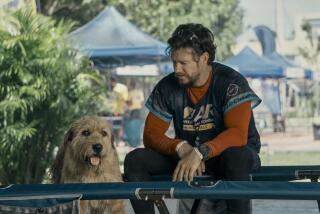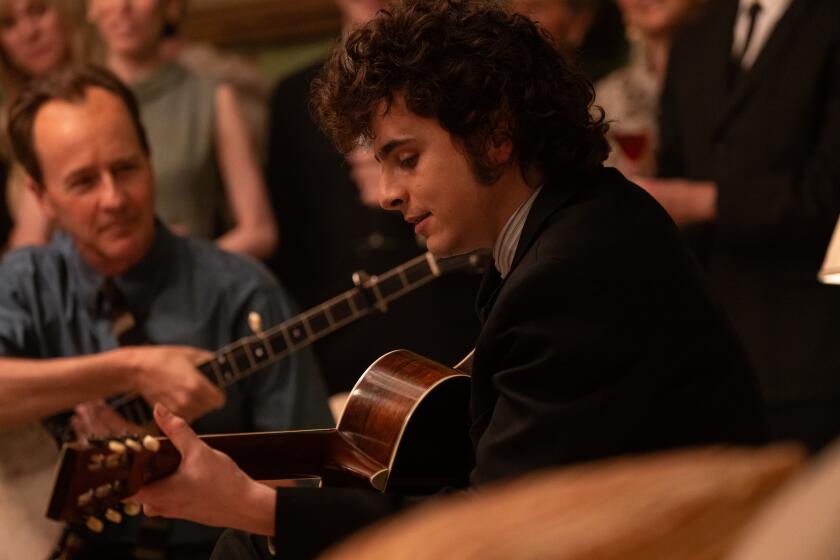Long trail of lies
In the deep shadows of the stippled dunes, a solitary figure silently prepares for an epic journey that will begin at first light. Frank T. Hopkins has brought his plucky mustang, Hidalgo, across the ocean to compete against the world’s finest Arabian horses on their own ground. All around him, pale robes that shield the Bedouins from dust, sand and heat swirl like butterflies. But doughty Hopkins wears the clothes of the Old West: dungarees, jacket, boots and Western hat. Hidalgo carries a stout Western saddle and gear.
The horses line up across the sand, milling and shifting for position as the starter lifts his gun skyward. Hopkins and Hidalgo stand quietly, awaiting the ultimate endurance challenge. Bang! The writhing line of horseflesh springs forward. Hopkins allows Hidalgo to start slowly, settle into his stride. The rider is in no hurry. He knows the task ahead and just how much horse he has under him. He is confident of winning the 3,000-mile “Ocean of Fire” race across the Arabian Peninsula.
Cut. Hold it.
There’s another take on the hero of the coming-soon movie “Hidalgo”: Frank T. Hopkins was not the greatest long-distance rider ever to jab his toe into a stirrup. Not even close. He was a counterfeit cowboy and gifted spinner of Old West yarns who lived in the industrial East and worked as a subway tunnel digger, harbor diver and circus horse handler. Disney may tout “Hidalgo” as “based on a true story,” but, according to a headstrong posse of fact-finders, the only thing Hopkins ever galloped across was the vast plains of his imagination.
For the few thousand riders worldwide who coax their mounts across hundreds of miles at a stretch, casting Hopkins as a real-life endurance hero is a slap to a centuries-old sport that requires great fortitude and fitness. When word of the film began to spread on the Internet last spring, skepticism about his far-flung -- and -fetched -- adventures turned quickly to incredulity and ultimately to outrage.
In the end, a scattering of experts, from museum curators and history professors to Old West and Native American scholars, joined the quest to validate claims that Hopkins made in magazine articles and an unpublished 1930s memoir that reads like “Pecos Bill Meets the Arabian Nights.” As Disney charged ahead with its “true story” marketing and merchandising spin, the research renegades, led by the co-founders of the Long Riders’ Guild, reached a unanimous verdict: all lies.
“Everything about the story is complete fiction. There was no Hidalgo,” said equine history buff Linda Merims of Norris, Tenn., who conducted her own months-long investigation.
She believes that Hopkins, who died in 1951, parlayed modest experience with horses into a false identity by using the Vermont Three-Day 100-Mile Ride as a platform. Sponsored by the Green Mountain Horse Assn., the 67-year-old event is one of the nation’s oldest organized distance rides. The articles he published in the association’s Vermont Horse and Bridle Trail Bulletin made him widely known among horsemen in the 1940s as “Frank Hopkins, the great 19th century champion distance rider,” Merims said. “GMHA believed him so totally that they invited him to judge their ride one year.”
“Hidalgo” screenwriter John Fusco, whose credits include “Crossroads,” “Young Guns” and “Spirit: Stallion of the Cimarron,” bought into the legend. He had become intrigued with Hopkins while researching his equine passion, the Spanish mustang. On the plains of the West, Fusco said, ranchers spoke reverently of a man who rode great distances to prove the mustang’s value.
But as the posse circled around Hopkins last summer, Fusco acknowledged that Disney would likely revisit the “based on a true story” blurb. “I had to take creative license with a sketchy story,” he said. “I had to create composite characters and dramatic incidents.” So, Fusco conceded, “myth and legend” infuse the film.
*
Remaking history
A facsimile of the “Ocean of Fire” dunes, ethereal and wind-swept, drew Bill Brummel Productions deep into the Imperial Valley last June to re-create the race for a History Channel documentary. Still unaware of Hopkins’ deceit and of the fact that Disney partly owns the History Channel, endurance riders from throughout Southern California answered the casting call, trailering their Arabians to the desert.
Under a staging tent on the morning of the dawn-to-dusk shoot, as horses and their costumed riders sweltered in the building heat, producer Bill Brummel explained that his researchers had stumbled while tracking Hopkins’ story. “We had a hard time finding any dependable research,” he said. “Everything seemed to go back to Frank’s own writing. As documentarians, we look for multiple sources to back up factual material. We couldn’t find a thing.”
In their effort, though, they contacted the Kentucky-based Long Riders’ Guild, a publisher and website devoted to riders who have ridden more than 1,000 miles in a continuous journey. Its founders, husband-wife team Basha and CuChullaine O’Reilly, fielded the queries and rounded up experts to hunt for the truth. They eventually published their own sweeping rebuttal of achievements attributed to Hopkins.
“Eighty academic experts in five countries helped us uncover documents showing Hopkins forged his equestrian credentials,” Basha O’Reilly said. “[He] lied about his participation in Old West events, falsely posed as a Native American, stole the identity and accomplishments of a congressional Medal of Honor winner and bragged about riding a horse to death,” she said. “The Hollywood caliphs should just admit that Hopkins looted the landmarks of other men’s lives.”
*
A tale with legs
It was easy to be fooled by Hopkins, especially after he hooked up with Charles B. Roth, a prolific Denver writer who penned a book titled “How to Use Your Imagination to Make Money.” Roth also cast Hopkins as a hero in magazine articles. In the mid-1930s he wrote, “Hopkins belongs at the head of the list of the world’s greatest distance riders.”
Roth later admitted he had not verified Hopkins’ claims, and in a 1956 article he seemed to defend such a lapse. “When we deal with the West, we deal with a myth,” he wrote. “It is a lusty myth, ... as beguiling, as immortal as any that came out of Rome and Greece. If you ask me, the myth of the West is about ten times as interesting besides.”
The timing is fuzzy and the circumstances are uncertain, but at some point Roth introduced Hopkins to Albert Harris, a pioneering Arabian horse breeder, who unwittingly bestowed credibility upon Hopkins. Harris’ 1941 book, “The Blood of the Arab,” included correspondence from Hopkins. In the ‘50s, J. Frank Dobie wrote admiringly of Hopkins in his classic “The Mustangs,” reprinting unverified excerpts from Harris’ book. This pattern of slipshod scholarship, continuing for decades, eventually sired “Hidalgo.”
How did Hopkins dream up his mustang’s unusual name? Probably while reading the Police Gazette, a sort of Sports Illustrated/National Enquirer of the day, said history buff Merims. During her research she spotted a reference in the Gazette to a California thoroughbred called Hidalgo.
“All roads lead back to Hopkins. Nothing predates Hopkins’ claims -- no magazine, newspaper accounts, nothing,” said Melissa Paul, curator of the W.K. Kellogg Library in Pomona, which houses the world’s largest collection on Arabian horses. After researching the “Ocean of Fire” race with her worldwide network of historians, Paul concluded: “What race? There has never been one.”
Frank’s fabrications ranged from riding a buffalo bareback to starring in Buffalo Bill’s Wild West show to “riding knee to knee with Teddy Roosevelt.” He claimed to be the son of a Lakota Indian princess, born in Ft. Laramie, Wyo., a dispatch rider for the U.S. government at age 12 and a pal of Billy the Kid.
Yet Juti A. Winchester, curator at the Buffalo Bill Museum in Cody, Wyo., found no evidence of Hopkins in her database of 6,000-plus people -- from mule skinners to popcorn vendors -- who worked for Cody. When Disney researchers called the museum, they asked how Buffalo Bill Cody dressed, spoke, etc. “They even wanted to know about what type of cigar he smoked,” Winchester recalled. “But no one from Hollywood ever asked a single question about Frank Hopkins and Hidalgo.”
Meanwhile, Breyer Animal Creations of Pequannock, N.J., plans to issue a model of the “legendary” mustang in a Wild West play set. And the virtual shelves at Amazon.com feature a book on Hidalgo written by R.H. Disney.
Charlie Nelson, vice president of marketing at Disney’s Buena Vista Pictures, confirmed in late January that “based on a true story” would remain as “Hidalgo” nears its March 5 release. Last week, Dennis Rice, Disney’s senior vice president for publicity, said simply that the company stands behind screenwriter Fusco’s research.
Despite mounting evidence, Fusco has maintained his commitment to his subject. “Frank Hopkins is a hero of mine,” he said, “and [the film] is based on his horsemanship philosophy. Maybe this is legend, maybe it’s created, but there is no doubt in my mind that Frank Hopkins was a knowledgeable horseman and acknowledged distance rider, and more importantly he was an early proponent of mustang preservation. Hopkins still lives as legend, as folklore in that world, and still inspires, no matter what the truth is.”
But Winchester is bracing for the questions of a curious public once the film hits the theaters. “No matter what Hollywood types say about it being ‘only a movie,’ we all know about the power of moving pictures on the human psyche,” she said. “I’ll be popping a lot of people’s bubbles. I only wish that somebody from that movie could be here to watch the fallout they started.”
More to Read
Only good movies
Get the Indie Focus newsletter, Mark Olsen's weekly guide to the world of cinema.
You may occasionally receive promotional content from the Los Angeles Times.










